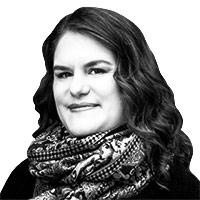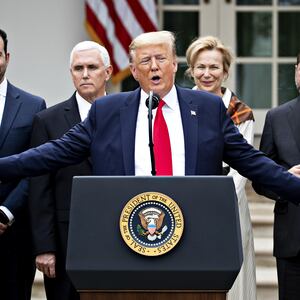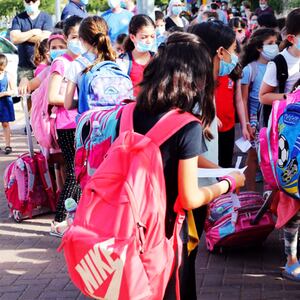I keep thinking about a moment in my career in education, when I taught at a small Catholic school for girls in Queens, New York. On one otherwise unmemorable morning, a student in my homeroom slid off her chair and onto the floor, mouth foaming, body convulsing: Something in the pot she’d smoked on the way to school caused her to overdose. I carried her out of the stuffy room and into the hallway, all the while yelling for help. The girls in my homeroom crowded around, fanning us, opening her collar, pulling my hair out of my face as I tried to make sure she was breathing, alternately panicking and calming each other down.
I’ve always thought about this incident as a story of bravery—of teenagers coming together with no warning to help someone in need. But now what I keep thinking is: There were so many of us, sharing so little air.
For me, for most of us in education, this is an ordinary and an extraordinary time. Ordinary, because it’s August and thus time to get ready to go back to school as I have for the last 21 years. Making syllabi, stocking up on pens, and considering a new backpack all feel deeply familiar. But this is an extraordinary time, too, because of the COVID-19 pandemic and the utter chaos it has caused for parents, students, and educators.
ADVERTISEMENT
The lack of realistic guidance has been shocking, and too many school administrators are apparently unable to think of any plan other than the “normal” beginning they hoped to have. The calendar seems to be pulling us towards a vortex where the ordinary and extraordinary will collide, when we’ll all be sharing too little air. It’s terrifying. Educators took one look at the photos that recently emerged from the crowded, nearly mask-less hallways of a high school in Georgia, and gasped for air.
I’m one of the lucky ones. These days I’m a professor at the University of Pittsburgh, my days of teaching high school are long gone. Pitt is allowing me to teach from home, and my students are young adults, capable of understanding why I’ve made that decision. My school year will begin with very little risk. But most of my former secondary teacher colleagues aren’t so lucky. As grateful as I am to have safe, meaningful work, I feel desperate for my friends, and for all teachers who are being asked to risk their lives to teach, who are being asked to do something extraordinary as if it was completely ordinary.
This sounds so dramatic, I know, this “risk their lives” business. But it’s true. We’ve already been asking too much of teachers, since Columbine, since Newtown, since Parkland. But now, in sending students back to in-person classes in the middle of a pandemic that has killed more than 160,000 people in America, we’re asking even more. We want these folks–students, teachers, administrators, janitors, aides, cafeteria workers–to go about their everyday lives at a time when ordinary interactions can kill.
I’ve worked in a dozen high schools as a teacher or teaching artist, and I can assure you that while every day certainly didn’t bring the drama of EMTs running down the hall to stop an overdose, in every class I had to ask at least one and often many students to adjust their behavior: to stop talking, stop laughing, stop singing, stop flirting, stop harassing. It’s not that teenagers are particularly troublesome, mind you. It’s that teenagers are humans, and humans, especially Americans, seem to be incapable of behaving in ways that inhibit the spread of the coronavirus. We keep settling back to ordinary, even at a time when it can kill us.
Part of me wonders if, in our desperation to get back to something approaching normality, we’ve simply managed to forget what high school looks like? Have we convinced ourselves that every high school in the country looks like the open-air California campuses often featured in Hollywood’s films? That students will stroll in neat, socially distanced lines? That it’s possible to seat 25 teenagers in one room with six feet between them all? That young people who lack power will give up one of their few forms of self-expression–their personal appearance–and wear masks as they’re told to? Has our level of self-delusion really gotten so bad that we expect, somehow, for schools to make an extraordinary effort to appear ordinary without actually being able to be so?
Those who haven’t spent time in a high school in years have forgotten how much more than classes happen there, how much living, and yes, how much dying. Thankfully, many incidents end reasonably well, as with my overdosing student who got the help she needed, first from those EMTs and then from her parents. But bad things happen in high schools, too, even in ordinary times. That same school year, one of my colleagues unexpectedly died at home, a death that unnerved and frightened our students. The question the students asked most often was “Why?” Why had she died? There’s no real answer to that question, in the face of death.
But at least my students never felt responsible for her death. As much as I think about all of those girls from my homeroom sharing too little air, I also think about their “Why?”s later in the year, as well. When the first teachers die from COVID-19, will their students ask “Why?” Or will they already know that they were part of the reason why? Is that when we will finally give each other some space to breathe? Is that when we’ll finally know that these are extraordinary, not ordinary, times?
Shannon Reed has been a teacher and professor in Western Pennsylvania and New York City for the last 20 years. She’s taught preschool, middle, and high school, and now teaches creative writing at the University of Pittsburgh. Her writing has appeared in The New Yorker, The Paris Review, The Washington Post, McSweeney’s Internet Tendency, and more. Why Did I Get a B? is her first book.








